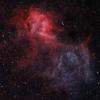Geostationary satellite in front of the shadow side of the moon?
Had some fun yesterday at excellent conditions with 110/660. Gave an assessment of the shadow side on the crescent moon at 9%. Aristarchus is easy to locate as brighter spot, so is Kepler and Copernicus, Kepler even better of the 2 i find. In fact it is the ejecta blanket of them what is perceivable. Also the 2 long prominent streaks from Tycho going up to Umbrium were to make out.
But, the fun point was satellites crossing the shadow site, hadn't registered such so far. In the first second I did not realize what was going on, but then, some moments later (CEST 22:54:05), one passed straight through the middle, clear to detect in 65x on the entire way, I guess it was something around 8-9m.
So the question is: a geostationary satellite would take +/- 120 seconds to pass the whole moon diameter. I wonder, has such thing ever been observed? I mean, one of the brighter around 10m I expect it could be seen visually.
regards
Edited by CHnuschti, 11 May 2024 - 08:37 AM.

















